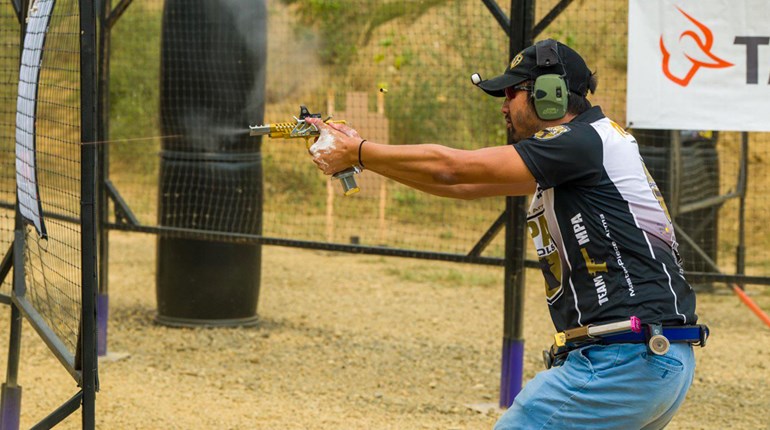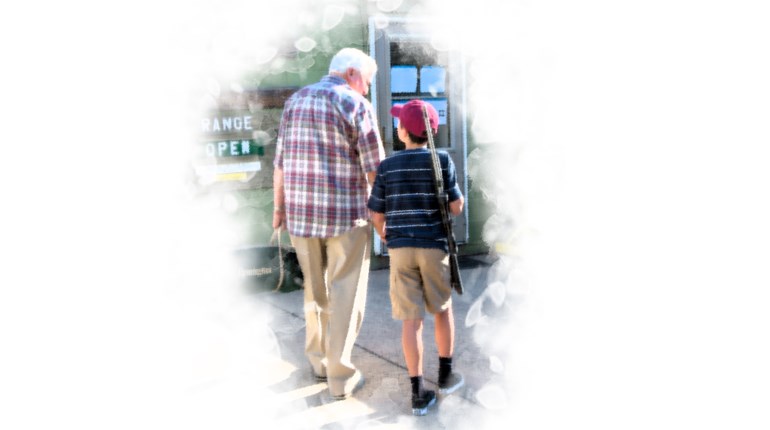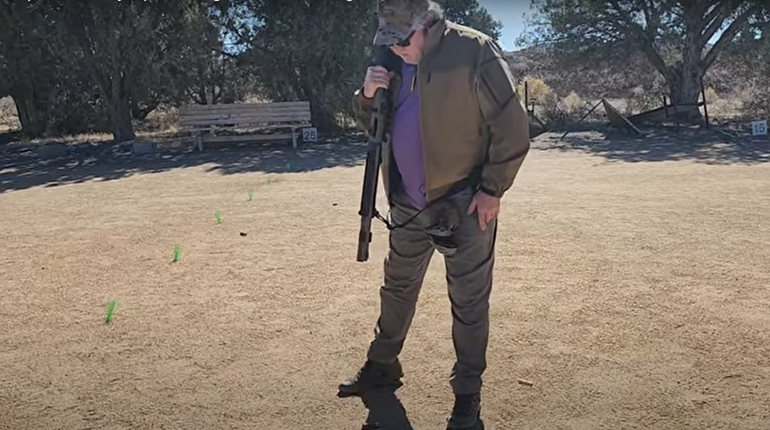
Picture courtesy of Kelly Grayson.
"Failing to plan is planning to fail." ~ Alan Lakein
So, someone kicks in your door in the middle of watching Sunday football, intent on stealing whatever he can to buy money for drugs. You've got a plan to defend yourself while shielding your family from danger, right? If a fire breaks out in your home, everyone knows where the fire extinguishers are? And failing that, I'm betting everyone knows their egress route and where to rendezvous outside the home.
When you're at the ATM at night, you try to mitigate the risk of being robbed, right? Perhaps you even avoid using the ATM at night? If you're away from home and someone breaks in, you've rehearsed with your family what to do, right?
"Honey, if someone breaks in, you take the cordless phone and lock yourself in the closet. Call 911, and stay on the line. And if someone opens that door who doesn't identify himself as a police officer, you shoot until there's no more threat. Got it?"
The point is, we spend a lot of time practicing what to do in a gunfight, and the prudent among us also plan what to do before and after a gunfight, or even better, how to avoid the gunfight altogether.
But I can tell you from many years of experience that most people's plan for medical emergencies consists of, "Panic, call 911 and wait desperately for the paramedics to arrive."
Too often, when we finally arrive, the patient is beyond help.
Like that great philosopher Admiral Painter said in "The Hunt for Red October," "The average Russkie, son, don't take a dump without a plan."
I'm betting your gun club or shooting range already has a place for that. What it lacks is a plan for when one of its Russkies gets injured.
An effective range emergency medical plan consists of the following elements:
- equipment and training
- range safety procedures
- communications and coordinating EMS response
- documentation and reporting
- medical care
Equipment and training
The time to discover that your range's first aid kit consists of little more than assorted Band Aids and an expired tube of Neosporin ointment is not when you desperately need something to stanch the bleeding from that .357-caliber hole in a patron's femoral artery. Take an inventory now, before the crisis, and stock up your range first aid kit with essential supplies. While it may be expedient and less expensive to improvise many bandages out of things like sanitary napkins and tampons, when you lack professional training in wound care and stabilization, the last thing you want to do is compound that handicap by improvising equipment. Buy good supplies, and keep them in a well-marked and organized first-aid bag or box. Essential supplies for any range first aid kit include:
- 4x4 gauze pads. Get an entire 50-count box of individually-wrapped pads.
- 8x10 absorbent pads. A half-dozen or so should do it.
- Battle bandage, such as a Cederroth Bloodstopper or Israeli Battle Bandage.
- Trauma shears.
- Nitrile exam gloves.
- Tourniquets. Two is one, one is none.
- 6-inch roller gauze. A dozen rolls should do it.
- 4- and 6-inch Ace bandages. Three of each should do it.
- 2-inch cloth or nylon tape. Get two. Tape tends to roll into inaccessible places when dropped. Have a spare.
- Chest seals, such as the Halo Seal or Asherman Chest Seal. You only need a couple.
- Hemostatic bandage or other clotting agent.
- Chemical cold packs. Four is plenty.
- A liter bottle of saline eye wash, or sterile water.
All of these supplies can be purchased individually online at a reputable EMS supply retailer such as Bound Tree Medical, and stored in an economy trauma kit such as this one.
The one item not listed here is the most expensive, but potentially most lifesaving. An Automated External Defibrillator (AED) is designed for use by laypeople for the victim of sudden cardiac arrest. An AED can cost $1,000 or more, but grant programs and partnerships with local hospitals and EMS squads can help to offset the cost.
Most public buildings and meeting places these days have an AED on-site, and shooting ranges and gun clubs should strongly consider purchasing one, as well. Let's face it, many of us lead a rather, well… sedentary lifestyle, and a sudden cardiac arrest at the range may be just as likely as firearm-related injuries.
Range safety procedures
I've performed cardiac-arrest resuscitations at nightclubs where the other patrons quite literally danced around us on the dance floor. At your range, the scene need not be so chaotic. In the event of a medical emergency at the range, use the following general procedure:
- Call a cease-fire. Everyone unloads and steps away from the line.
- Evaluate the situation. Are the injuries minor or major?
- Clear the immediate area of everyone not directly involved in providing care. Everyone in contact with the patient, keep your eye protection on. Not only does it protect you from flying metal and unburnt powder, it can protect you from spurting blood. You're far more susceptible to infection from blood splashes in the eyes than from getting it on your hands.
- Designate helpers. You need someone to call 911, someone to fetch the first aid box, and someone to assist with care. If anyone is left over, or so frozen/panicky that they're hindering the operation, designate that person to wait at the range entrance and flag down EMS personnel.
- Render aid.

Communications and coordination of EMS response
Coordination of EMS response should begin long before the call to 911. By their very nature, shooting ranges are often situated in rural areas. If your club has a long-range rifle range, it's a cinch that the club is not located within city limits where EMS units are nearby, and it may be so remote that cell phone coverage is poor or non-existent. Where EMS response time is prolonged, pre-planning and coordination with response agencies can save lives.
Contact the chief of your EMS squad and the operations supervisor at your 911 operations center, and make sure they have directions to your range in their database, including the entry gate combination, if there is one.
If your range is truly remote, find out from the chief of your local rescue squad which agency provides aeromedical response to your area. Coordinate with that agency, and designate a nearby landing zone for the helicopter. You need an area with a minimum of 100x100 feet, well-lit, with no utility wires or ground hazards present. A 100-meter or longer rifle range would be perfectly suited for this. Make sure the aeromedical response agency has the GPS coordinates of the range in their database. Many such agencies will come to your facility and teach a ground coordination and landing zone class, free-of-charge.
Another thing laypeople may not often consider is that when the words "gunshot wound" are uttered to a 911 dispatcher, law enforcement will usually respond prior to EMS. Often, the responding EMS crews are merely given an address, not the name of your range or club, and thus are unaware that there is little potential for personal danger to them. These precious minutes wasted staging until law enforcement clears them to enter may cost a life. Coordinate with EMS and law enforcement agencies to remove those artificial barriers to care.
Lastly, when you make the call to 911, make sure your designee communicates effectively and relays the proper information:
- Caller's name
- Facility name
- Facility address
- Contact phone number
- What happened - ONLY THE FACTS
- Location within facility of incident
- Location of person meeting LEO/EMS
- DON'T HANG UP!
Documentation and reporting
You may need to check your local and state statutes for the exact wording, but in most states, gunshot wounds are required by law to be reported to the appropriate law enforcement agency. Failure to do so may expose you or your club to criminal and civil liability. In some states, mandated reporting extends not only to gunshot wounds, but also to any injury resulting from firearms, ammunition or their components. This requirement may apply even if the victim did not seek care at a hospital. Know your local and state laws, and report accordingly.
It's a good idea for the RSO to keep a written record of the events, including the following:
- Document times of all actions taken / aid rendered.
- Document name(s) of injured person(s).
- Document names of everyone participating in incident.
- Identify individuals willing to provide statements to LEO.
- Assume everything you document will be read by attorneys for both sides in a court of law.
- Only document facts, not opinions.
Rendering aid
If your shooting buddy goes into cardiac arrest and your range is more than 10 minutes from the closest ambulance, it's a virtual certainty that your buddy will not survive the event without the CPR and defibrillation you provide. If someone has a significant arterial bleed, you have roughly 30-60 seconds to react. If those seconds are not used wisely, the best trauma care in the world may not save them.
Formal training in first aid and CPR is beneficial, but let's not overcomplicate things. The vast majority of truly lifesaving techniques can be safely rendered by laypeople. Detailed information on various wound care and first aid techniques is the subject of another article entirely, but it all boils down to this: Air goes in and out, blood goes around and around. Correct any variations on this theme. If the patient has no pulse, push hard and fast on the chest until EMS arrives. That said, the range should always have someone present who is CPR certified at the very least.
Get your range emergency medical plan in place, and practice safe shooting!




































